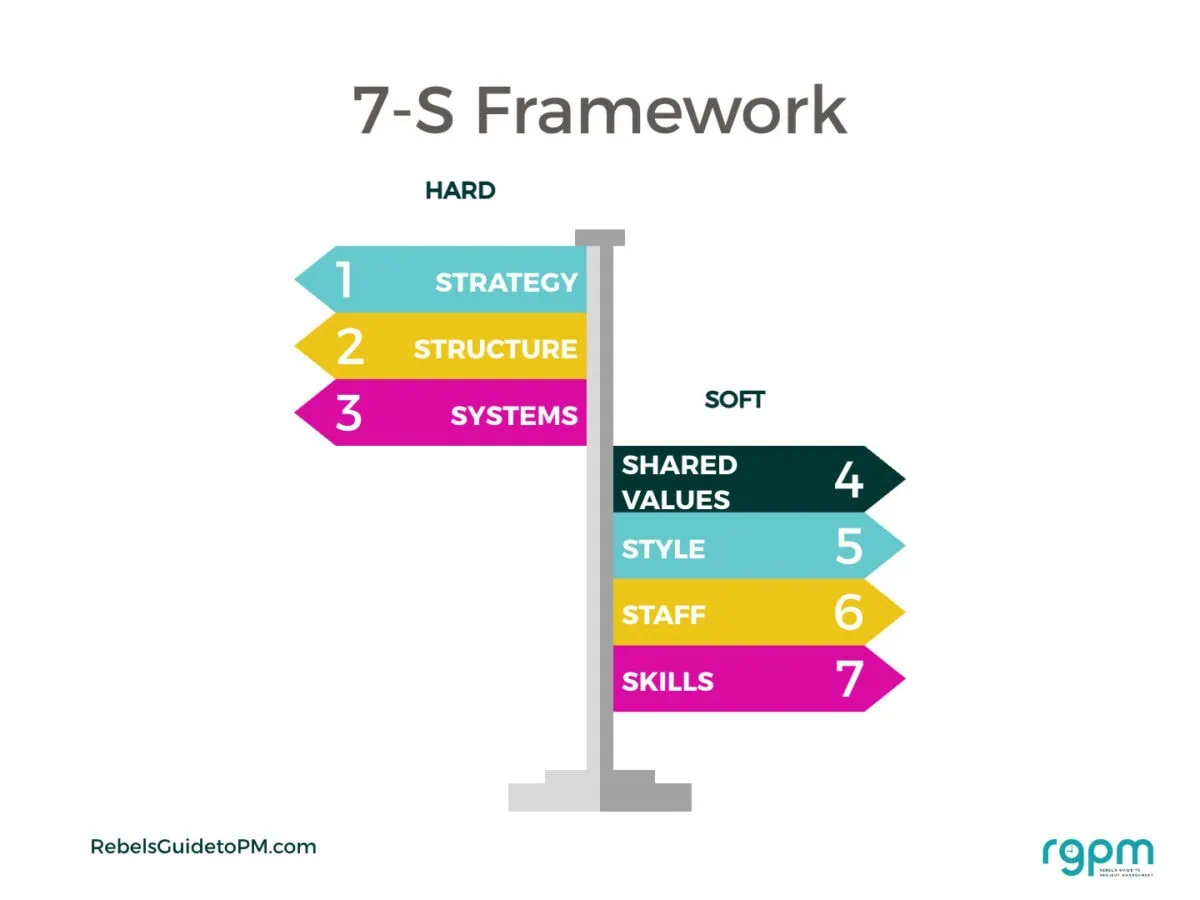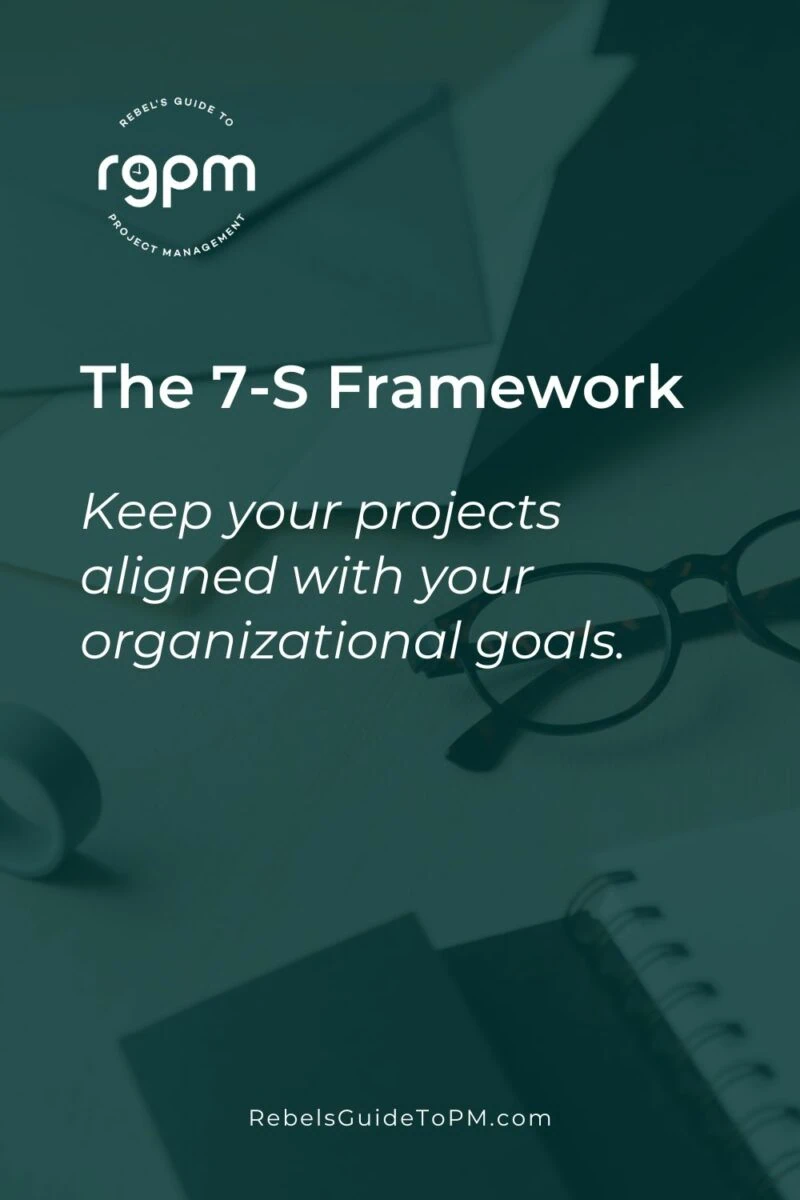The 7-S Framework: Project Management Remix
When it comes to project management things can move really quickly, and sometimes that means things get out of hand. When you’ve got a lot to do, ensuring that your project is aligned to your organizational goals becomes even more important – it’s too easy to let slip that strategic alignment that we have heard so much about in the project management press over the past year or so.
Staying on top of everything and staying aligned to the organizational goals is easier with the tools and techniques to help you.
This is where project management methodologies, models, techniques and task management software comes into play. They streamline your tasks and keep you on track to achieve success.
The 7-S Framework
One of those models is the 7-S framework, a tool for understanding the complexities of your organization.
Introduced by thinkers at McKinsey in the 1970s, it was a revolutionary way of thinking about how organizations worked. Previously the focus had been on hierarchy and the physical structure of a firm.
The 7-S model focuses more on coordination through a connected web of factors that affect how an organization is able to work and change.

7-S for Project Management
The 7-S framework wasn’t designed with project management particularly in mind, but it is useful in determining how aligned your project goals are with your organizational goals and what needs to be done to improve the correlation further.
The framework breaks down into – surprise! – 7 categories, split into hard and soft elements.
Let’s look at those with a particular focus on how they relate to project management.
Hard Elements
The hard elements cover three factors: Strategy, Structure, and Systems.
Hard elements are easier to identify, define and understand for project managers because these factors hugely influence your projects. You’ll be using them every day.
Everything from formal processes, strategies, reporting, organizational charts, and IT systems falls under this category.
1. Strategy
Setting project objectives is not enough to achieve success. You should have a plan and strategy about how to be successful and how to achieve your objectives.
The project plan and strategy should be well documented and communicated to all team members. The project strategy should focus on how to build and maintain a competitive advantage over the competitors. Strategy can change with changes in situation and external environments: most likely your project sponsor and project board will steer your work here.
2. Structure
This element relates to who will report to whom. Organizational charts for your project and other related resource documents fall inside the Structure element of the 7-S model.
Irrespective of the project scope of the implementation, it is important that you and your team members are clear about who reports to whom.
A roles and responsibilities chart can also help, or a RACI matrix. There are lots of ways to make sure project structure is clear.
3. Systems
The System element reflects how the tasks will be completed and what process will be followed. It covers areas related to business operations and the business of running projects.
Systems can include project management software and collaboration tools, but are also broader than that: the processes, formal and informal ways of working that get things done in your organization.
As a project manager, you probably spend a lot of time removing bottlenecks for your team to ensure they can fulfil their responsibilities and achieve better results. That’s all systems work.
Soft Elements
There are four Soft elements: Shared Values, Style, Staff, and Skills.
Soft elements are difficult to quantify and are heavily dependent on the organizational culture, making them much harder to put into practice successfully in a project environment.
4. Shared Values
Shared values are the first soft element that deals with organizational culture. It is the shared values that bind the project team together and foster cohesiveness and teamwork.
These characteristics run deep down the organization; companies never let go of them, no matter how grave the circumstances. Both the corporate culture and general work ethic also reflect shared values.
You may have posters up in the office or a screensaver that puts company values front of mind. Or you may just get a feeling of ‘that’s the way things are done around here’.
5. Style
This element relates to leadership style. The leadership style you adopt as a project manager will directly influence your team. It’s important that you select the style carefully [the situational leadership model will help here – Elizabeth] after assessing the situation to choose a response that will get the best out of the situation and the team members involved.
Flex your leadership style as your project requires.
Read next: How to delegate tasks
6. Staff
People are the most valuable assets of a company. Managing your staff efficiently and getting the best out of them is the core responsibility of a manager, and even project managers without line responsibility for their teams have a huge influence over the individuals involved in the project.
Get to know your team so that you can help them develop their skills and provide them with the opportunities where they can grow as a professional.
This will also help you in retaining your best talent and reducing the employee turnover rate.
7. Skills
Closely related to the previous point, the Skill element of the 7-S model focuses on the number of skills and levels of skills your team members have. Good project managers spend time with every individual to get to know them better and evaluate their skill levels.
That goes for you as well: project managers should invest in their own personal development through training programs, workshops, seminars, and visits. In today’s dynamic and competitive world of project management, you should always look for opportunities to learn new things in order to compete with your competitors.
Investing in development activities for yourself and your team can reap rewards in future. It will help you in getting most out of your employees in the long run. And give your all some extra project management skills for your resume.

Theory is only useful if implemented
It’s likely that these elements aren’t new to you, although the McKinsey framework might be. They all form part of the competencies expected of project managers.
The problem lies in implementation. Are you really using all these elements to help drive project success? Or did you just write about them in the Project Charter or terms of reference and then let the principles slip a little?
If you want to achieve your project goals (or any organizational goal), then it’s important that you focus both on the hard and soft elements of the 7-S framework, giving them all equal importance. Ignoring the soft elements in particular can wreak havoc on the chances of project’s success and will destroy the organizational culture.
Make it work for you
Looking to put this approach into practice? Here are some steps to take now.
- Download a free organizational chart template so you can start to document the hierarchy of your project.
- Learn what should be in a project plan (there are free templates included in that article too).
- Review your project charter and see if it could be updated in light of this model.
- Think about your professional development. Schedule in some time to watch one of my free project management webinars (which also count towards your CPD/
PDU requirements for professional certifications).
About the author: At the time of writing, Atif Shahab was a Senior Community Manager at task management software TaskQue. He is a fan of classic music and loves traveling with friends. When he is not doing anything, he looks after his plants in his homegrown garden and spends time with his pets.
This article first appeared in 2017.
